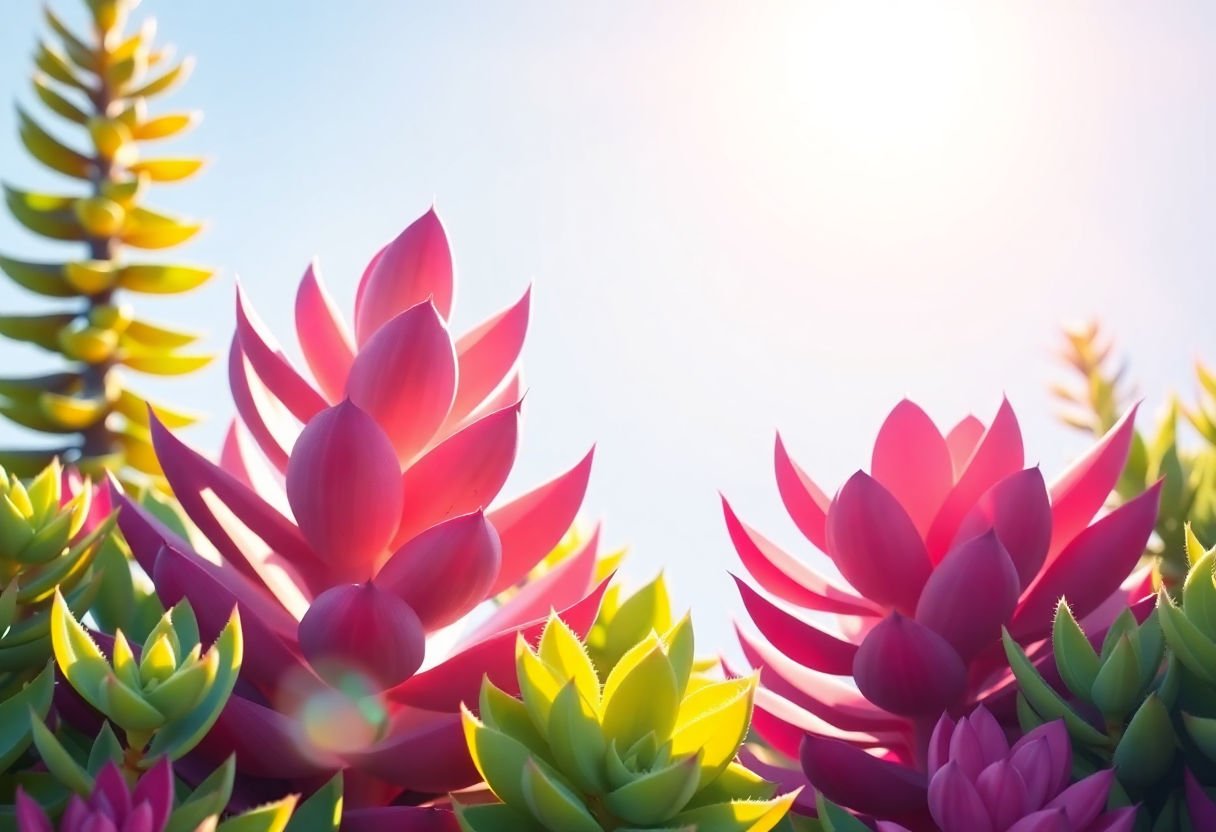Succulents can brighten any space with their unique shapes and colors. But these hardy plants need the right sunlight to stay healthy. Too much or too little can cause issues. This guide explores how much sunlight different succulents need. It shows how to arrange them indoors and outdoors for ideal light. You will learn to spot signs of sunlight problems like stretching and color change. With helpful tips, you can keep your succulents thriving. Whether you grow them inside or out, understanding sunlight needs is key to their vibrant life.
Key Takeaways
- Different succulents need different amounts of sunlight, so it’s important to know the requirements of each type.
- Indoor succulents can thrive using windowsills and grow lights to get the light they need.
- Outdoor succulents benefit from shade and proper positioning to avoid harsh midday sun.
- Signs of too little sunlight include stretched growth and color fading.
- Seasonal changes affect sunlight, requiring adjustments in plant care routines.
Basics of Succulent Sunlight Requirements
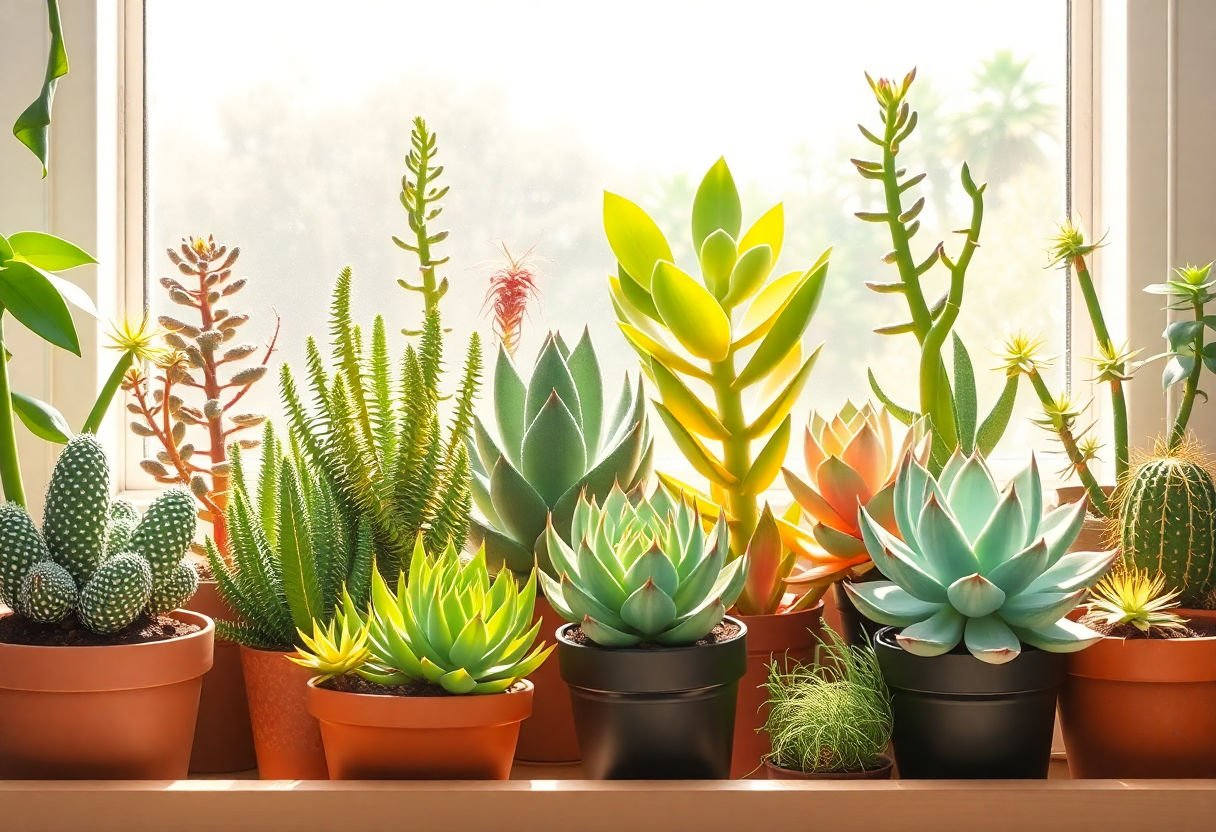
Succulents usually enjoy about 6 hours of sunlight each day. They need this much sunlight to grow strong and stay healthy. Too much or too little light can cause problems, though.
Too Much Sunlight:
If succulents get too much sun, they can get sunburned. Just like people, they do not like getting too hot and dry. Their leaves might turn brown or get dark spots. This can harm them.
Too Little Sunlight:
On the flip side, if succulents do not get enough light, they might look pale or grow tall and thin. This happens when they stretch to find more sunlight. This is called etiolation. You might notice their color fading, which means they are not happy.
Different succulents have unique needs. Some do better in bright light. Others like indirect sunlight. For example, Aloe Vera loves bright, direct sunlight. On the other hand, the Zebra Plant prefers indirect sunlight.
Keeping these differences in mind helps your succulents flourish. Here are some simple tips:
- Watch their color and shape. This gives clues about their light needs.
- Move them around. If you see signs of too much or too little light, try a new spot.
- Be patient. Some take time to adjust to new lighting.
Understanding these basic sunlight needs helps ensure your succulents stay bright and cheerful!
Identifying Sunlight Needs for Different Succulent Types
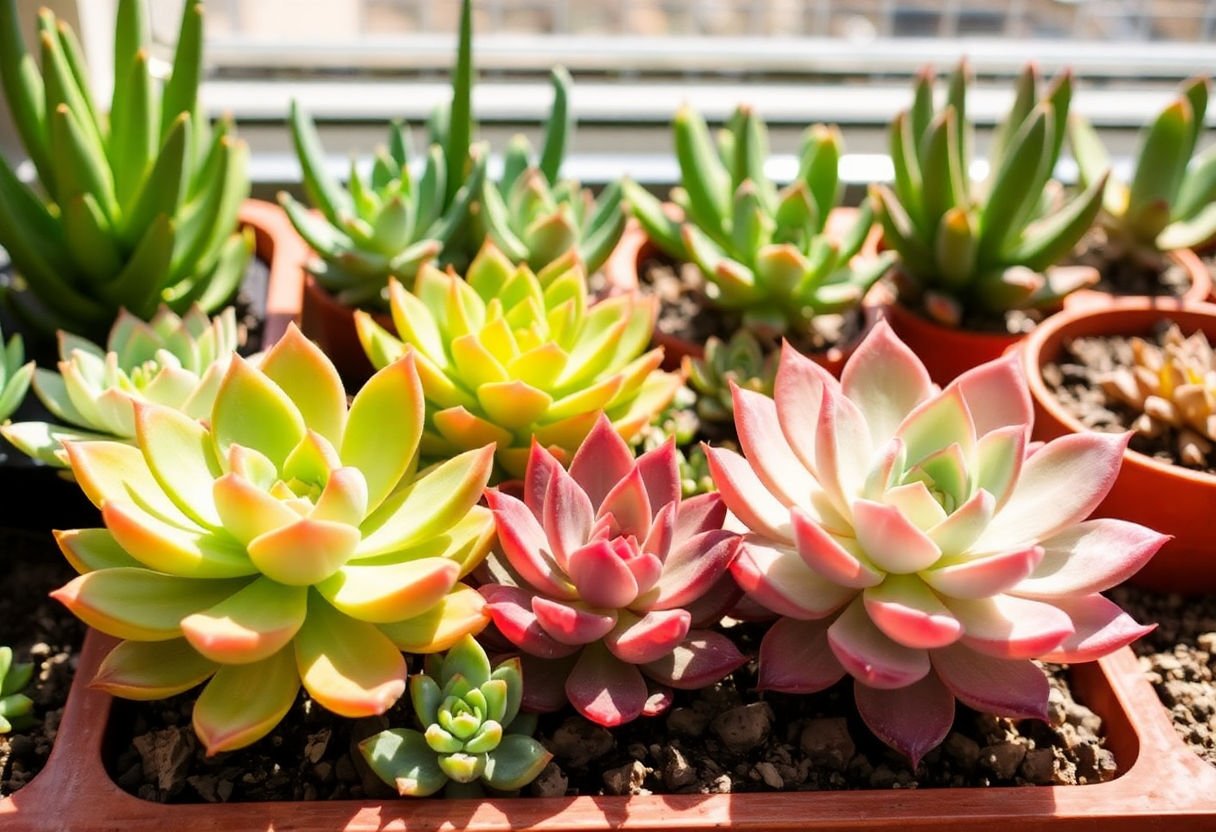
Different succulents need different amounts of sunlight. Think of succulents like people at a beach. Some love soaking up sun all day. Others prefer staying in the shade.
Agave and Aloe love sunlight. They want direct sun for about 6 hours daily. An ideal spot? A south-facing window.
Echeveria enjoys bright light too, but too much can cause brown spots. Give it full sun in the morning and some shade in the afternoon.
Haworthia plants prefer less intense light. Bright, indirect sunlight works best. Near an east or west window is perfect for them.
Jade Plant likes a mix: morning sunlight and afternoon shade. Too much direct sun can dry it out.
Here’s a simple table to help:
| Succulent Type | Sunlight Need |
|---|---|
| Agave, Aloe | Full sun for 6 hours |
| Echeveria | Morning sun, PM shade |
| Haworthia | Bright, indirect light |
| Jade Plant | Morning sun, PM shade |
Too much sun can cause sunburn. Not enough can make them stretch. Look for these signs. Note any changes. Move your plant if it needs more or less sun.
Remember: Check on your succulents regularly. Their needs can vary with the seasons. Adjust the sunlight based on how they appear and where they are placed in your home.
Signs of Inadequate Sunlight Exposure
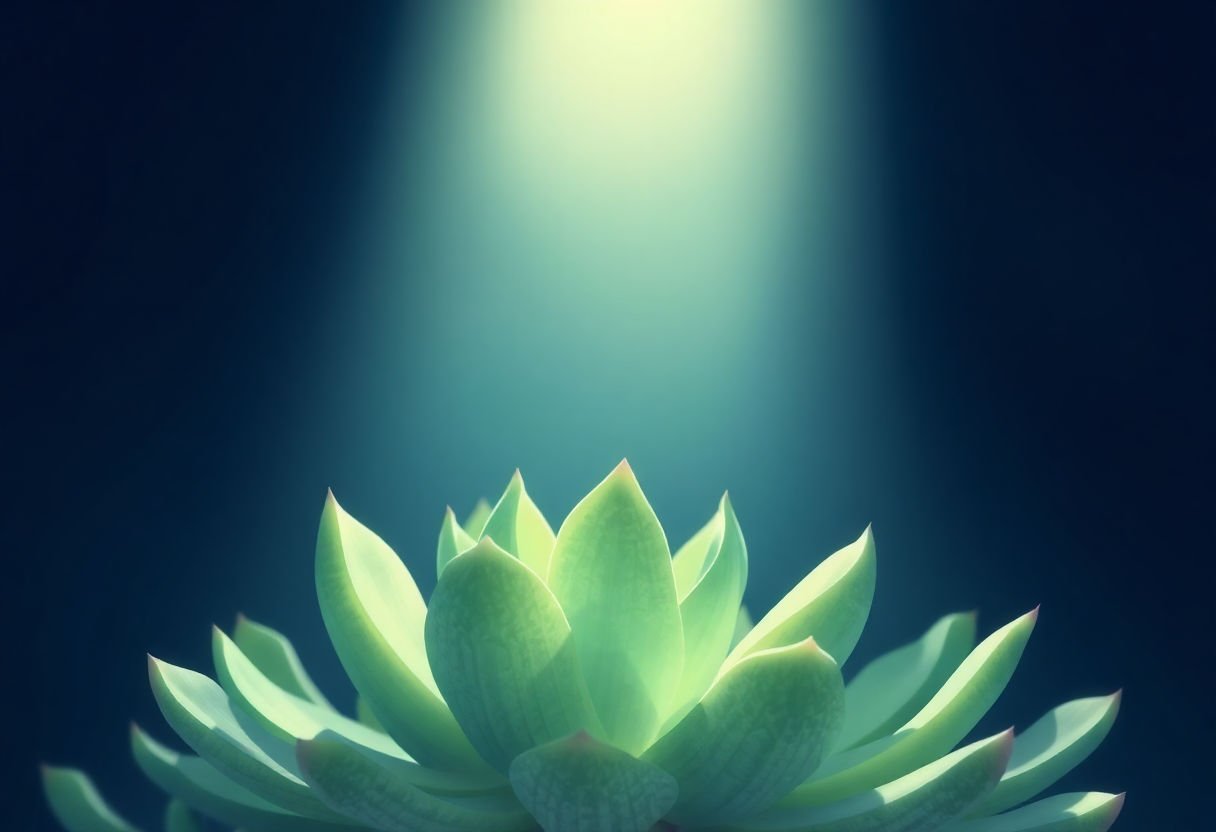
Succulents can show several signs when they don’t get enough sunlight. One common sign is etiolation. This means your succulent starts to stretch out. It reaches for more light. Stems grow longer. Leaves become spaced out. The plant looks thin and weak.
Color changes can also indicate problems. Succulents usually have bright hues. When they lack sunlight, colors fade. They might turn a dull green. This shows they’re not healthy.
Leaves may droop or bend. They might appear soft. A sign that they lack energy. Sometimes, leaves wither. This shows the plant needs more light to survive.
Some succulents grow towards a light source. They tilt to one side. If a plant leans a lot, it seeks more sunlight. This bending can change the plant’s shape. It’s trying to soak up all available light.
To check for these signs, look at your plants often. Watch for changes in growth patterns. Keep an eye on leaf color and position. Be ready to move them to a brighter spot.
If you notice these symptoms, act quickly. A window with more sunlight or gentle light can help. This can help the plant get back to health. Look for ways to increase light exposure for your succulents. This helps them stay healthy and vibrant.
Managing Outdoor Sunlight Exposure
To manage outdoor sunlight for succulents, pay attention to their placement and exposure. Shade plays a big role. Succulents can scorch like our skin under direct sun. An umbrella or tree can help reduce the harsh midday sun. Think of them like a canopy to shield from harm.
Consider how long the sun hits your plants. Morning sun is gentler. Place succulents where they catch this light but hide during the hottest parts of the day. South or east sides work well. The west can get too hot during summer.
Rotating pots can help, just like turning a rotisserie chicken. This ensures each side gets equal exposure. Uneven light can lead to leaning. Use this trick to keep growth even and steady.
Changing the angle can matter too. A slight tilt toward the sun might help those on balconies or in tight spots. Imagine leaning toward warmth without getting too close to a fire.
Mulch can protect roots from heat. A layer of pebbles cools the soil. Think of it as adding insulation to keep a comfortable temperature.
In summary, use shade, rotation, and timing to manage outdoor sunlight. With a bit of planning, succulents will thrive outside.
Maximizing Sunlight for Indoor Succulents
To help indoor succulents grow strong, you need to boost their sunlight exposure. Windowsills make great spots. They provide natural light, which succulents love. Aim for a south or east-facing window.
If natural light is scarce, grow lights can help. These lights mimic the sun’s rays. Place them about 6 inches above your plants. Turn them on for about 12 to 14 hours a day. Think of it as a little sunbath for your plants.
Rotating your succulents gives each side equal light. If one side gets more light, the plant leans that way. So turn them a bit every week. This keeps them straight and balanced.
When choosing a spot, watch out for heat from radiators or AC vents. These can dry out or chill your plants. Succulents prefer a steady, warm environment.
Remember, succulents can have too much sun. If you see brown spots or shriveled leaves, they might need less direct light. Move them a bit away from the window or add a sheer curtain.
Using these simple methods, indoor succulents can thrive with the right amount of light.
Seasonal Sunlight Variations
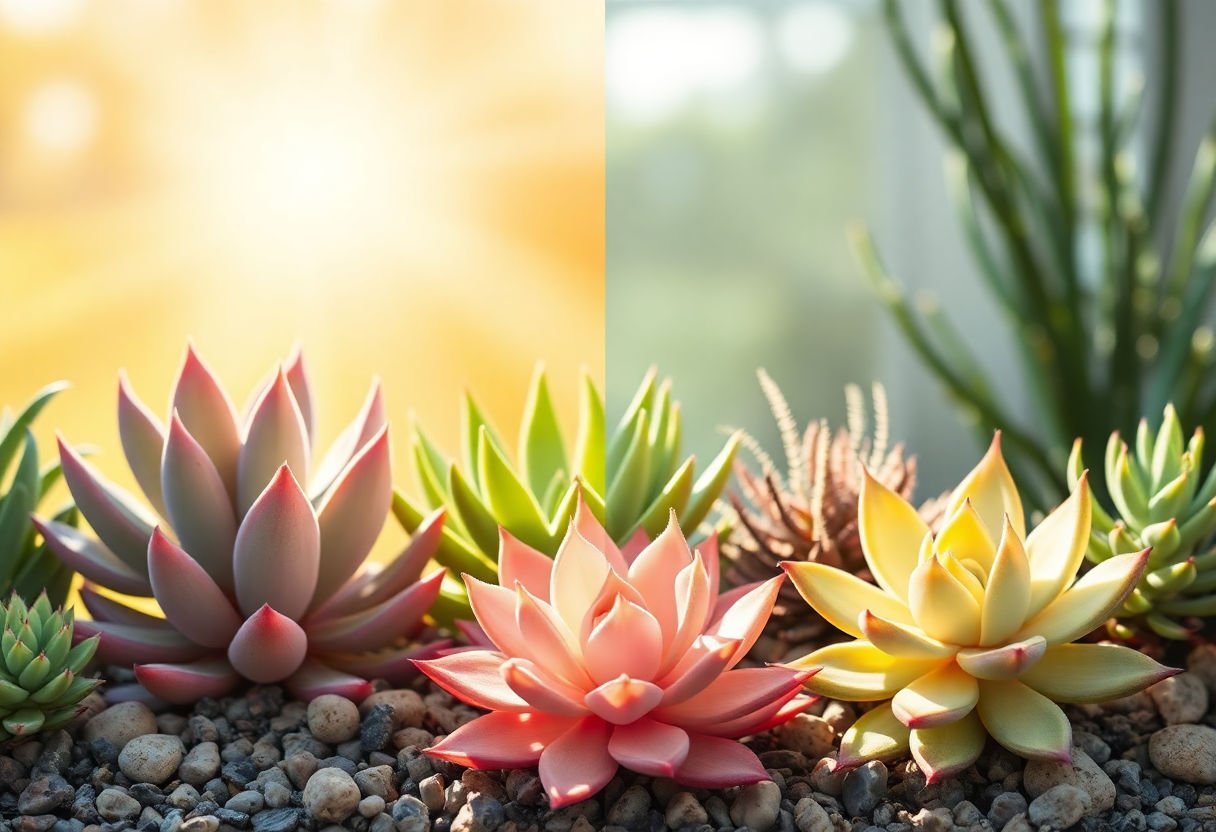
Succulents, like any plant, respond to seasonal changes in sunlight. These changes affect both light intensity and duration.
In summer, days grow longer, and the sun shines brighter. Succulents soak up these abundant rays. More light helps them thrive and produce vibrant colors. Position your succulents where they can bask in this extra sunlight, but watch for signs of sunburn.
Winter tells a different story. Days become shorter, and light grows weaker. Succulents may not get enough light indoors during this time. Here, positioning near south-facing windows helps. When natural light isn’t enough, grow lights can fill in the gaps. Aim for about six hours of light daily.
Spring and fall offer a middle ground. Light increases in spring, helping succulents recover from winter’s low light. Fall brings gradual light reduction. Adjust placements gradually during these transitions. This helps prevent shock to your plants.
Tips for managing seasonal sunlight:
- Summer: Provide some shade during peak hours to avoid sunburn.
- Winter: Use grow lights as a supplement when daylight wanes.
- Spring and Fall: Gradually shift plants as light changes with the seasons.
Remember, observing your plants is key. Adjust based on their response to light. This keeps them healthy and happy, regardless of the season.
Preventing Sunburn and Damage
Succulents enjoy sunlight, but direct sun can harm them. Think of them like a friend who loves the beach but needs sunscreen. Without protection, the sun can burn them.
Sunburn in succulents appears as brown spots or patches. These spots don’t heal. The plant can’t reverse them. Affected leaves might even drop off. But don’t worry. You can protect your succulents from this.
Start with gradual sunlight introduction. Place new succulents in a shaded spot first. Slowly increase their time in the light. Like getting a tan before summer, introduce more light over weeks, not days.
In hot seasons, protect your plants. Use a sunshade or net. These act like umbrellas. They cut the intense rays but still give light.
Watering is key too. More sunlight can dry them faster. Keep an eye on the soil. Water when dry, but don’t overwater. Damp soil can get too hot and hurt roots.
If you move succulents indoors, place them near windows. Choose spots where they get bright but indirect sunlight. Rotate them every few days. This way, every side gets equal sun. This prevents leaning or uneven growth.
Be mindful of time and conditions. With these steps, your succulents will stay healthy without the risk of sunburn. They’ll thank you with vibrant colors and growth.
Realigning Artificial Light for Indoors
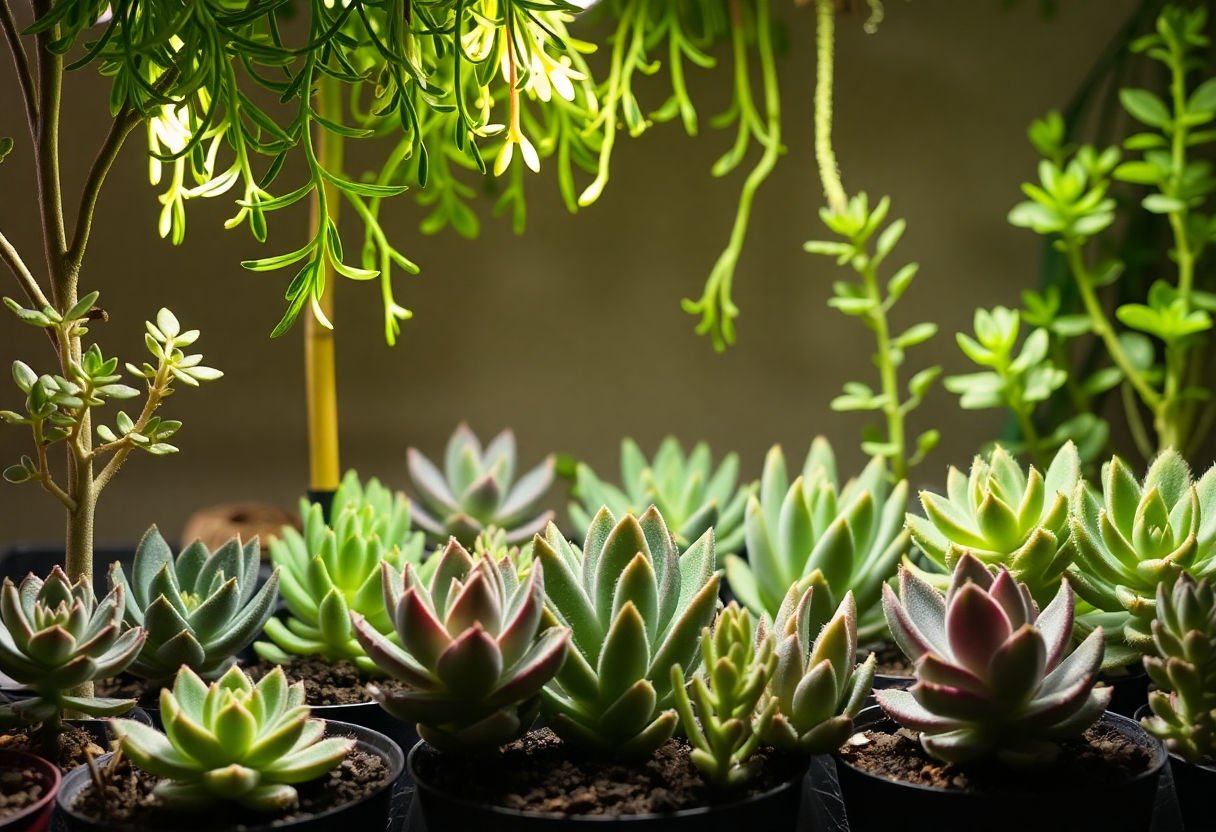
Succulents love light. Indoors, though, they can’t always get enough of it. That’s where artificial light comes in. You can mimic the sun’s rays with special lights. It helps succulents stay healthy and look vibrant.
First, pick the right bulb. LED grow lights work well. They use less energy and last long. Fluorescent lights can work too. Both types give off the kind of light plants need.
Next, find a good spot. Place the lights close to the succulents. Usually 6 to 12 inches away. This way, the plants get plenty of light. For best results, keep the lights on for about 12 to 16 hours a day. Think of it like setting the sun and waking it up later.
Monitor your plants. Look for signs of too much or too little light. If leaves turn brown or fall off, the light might be too strong. If they don’t grow or are pale, they need more light. Adjust the distance or number of hours the lights are on.
Rotating the plants helps a lot. Turn them every few days. This way, each side gets equal light. Succulents will grow evenly and look strong.
Finally, be patient. It takes time for succulents to adapt. Watch them closely, and make small changes as needed. They’ll thrive with the right amount of light. They will reward you with their beauty and resilience.
Conclusion
Proper sunlight management ensures healthy succulents. It’s like giving them the right food. Not too much, not too little. Learn each succulent’s specific needs. Outdoor or indoor, align their exposure with the changing seasons. Remember, signs like stretched stems can mean not enough light. Sunburnt leaves signal too much. Balancing sunlight keeps them vibrant and strong. By meeting these sunlight needs, you nurture thriving and beautiful plants that brighten any space.
Frequently Asked Questions
How much sunlight do succulents need daily?
Succulents generally need about 6 hours of bright, indirect sunlight each day. If you place them near a window, they can often get the light they need without any extra help.
Can succulents get too much light?
Yes, too much direct sunlight can cause sunburn. Look for signs like brown spots or a pale color. Move them to a shadier spot if this happens.
Are there specific succulent types that need less sunlight?
Some succulents, like certain Haworthias and Gasterias, grow well in lower light. They thrive with indirect sunlight, making them suitable for spots away from windows.
Where should I place indoor succulents for the best light?
Place them on windowsills facing south, east, or west. Rotate the pots every week to ensure even light exposure, helping the plants grow straighter.
Do succulents need less sunlight in winter?
Yes, they enter a dormant phase in winter. During this time, they need less light and water, so you might have to move them to a brighter spot or use a grow light.
